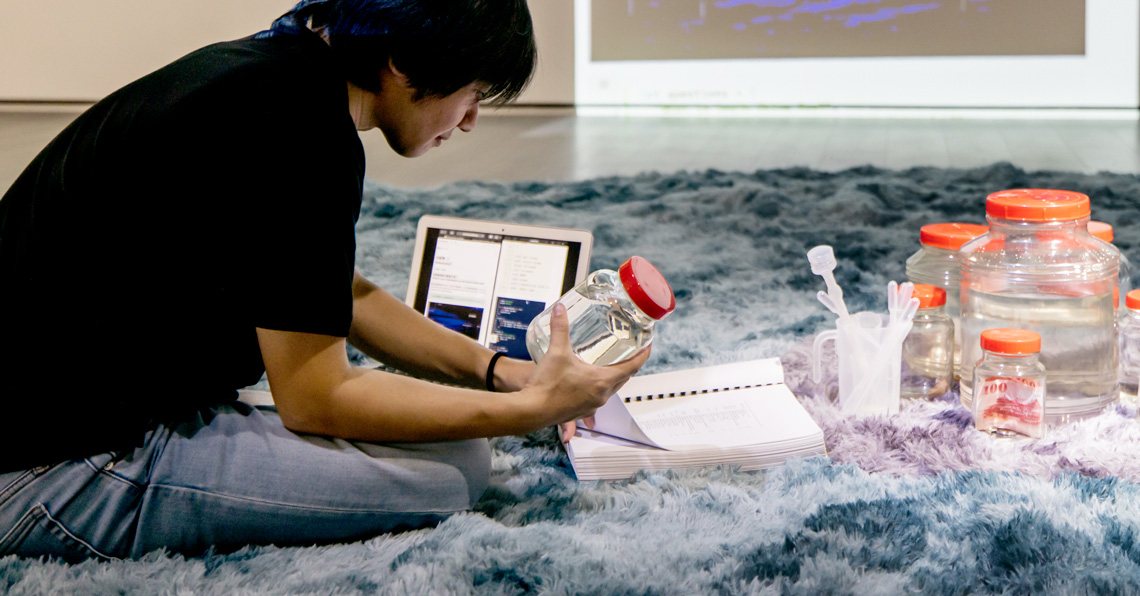How to Buy/Own/Mint One Milliliter of the Ocean from the South China Sea
Issue: XXIX.4 July - August 2022Page: 10
Digital Citation
Authors:
Winnie Soon, Tzu Lee
The South China Sea (Mandarin: 南海, Nan Hai) is one of the world's most heavily trafficked waterways for international trade, but it also is the site of complex territorial disputes spanning Brunei, China, Malaysia, Taiwan, the Philippines, and Vietnam. Multiple Asian governments assert sovereignty over rocks, reefs, and other geographic features and undersea natural resources.
This oceanic object is highly tangible and material, yet it has other economic, military, and political lives. Imagine the dotted lines on a map across Nan Hai. What would happen if these lines no longer represented the competition of territorial boundaries and colonial power but instead linked together marginalized individuals in "kinship" connections, based on mutual respect for one another's traditions and histories? The art project Forkonomy() asks how we might "queer" the South China Sea otherwise, by subverting ideas of ownership and possession through digital art practices. Our guiding question: "How can we buy/own/mint one milliliter of the ocean from the South China Sea?"
On December 19, 2020, we gathered diverse participants for a workshop at C-LAB in Taiwan, during the Lab Kill Lab exhibition. Invitees included policymakers, scholars, marine life conservators, cultural workers, artists, and activists. Through participatory discussion, auction, contract making, and a code-certificate performance, we explored what it meant to queer the ownership of one milliliter of Nan Hai's water.
 |
Forkonomy() - version 2 (2021) as part of Dear Block Chen, exhibited at Solid Art in Taiwan. |
 |
Code certificate in Forkonomy() - version 1 (2020). |
 |
Auction in Forkonomy() - version 1 (2020) as part of LAB KILL LAB at C-LAB in Taiwan. |
 |
Forkonomy() - version 2 (2021) as part of Dear Block Chen, exhibited at Solid Art in Taiwan. |
In Version 1 of the artwork, the workshop participants decided that the milliliter of Nan Hai should be co-owned as a "cooperative" with the set price of 1.61 TWD (New Taiwan Dollars)/ml. As part of the association, each participant agreed to take ecological and economic responsibility for the South China Sea collectively and cooperatively.
In Version 2 of the artwork, we put the co-owned one milliliter of Nan Hai as an NFT (non-fungible token) on the blockchain network, a decentralized and distributed protocol that facilitates the recording of asset transactions, with the aim of further exploring the notion of ownership. We have published 10,000 editions of the cooperative contract (written in English, Chinese, and computer code), and its potential royalties will be used to generate the subsequent 10,000 editions in an endless cycle of edition production.
This means that we are generating more water buyers as co-owners of Nan Hai, with every transaction recorded on the blockchain and therefore beyond national sovereignties. As part of Forkonomy(), the NFT work is an ongoing art action that takes the figurative and pirated material—the South China Sea—as the object of study with which to experiment, speculate, and make alternative changes.
What does it mean to mine and to co-own one milliliter of the ocean from the South China Sea? We are interested in rethinking the politics of our contemporary economic and technical-cultural systems. By employing free and open-source software and decentralized protocols, we set up the participatory project as a commoning ship for people of the Pacific who care about and want to queer hierarchies, ownership, and gendered labor division, as well as fight against the constant threats to maintaining a high degree of autonomy over the land and the sea. Forknomy() shall sail the economy and autonomy into a queer ocean of freedom and the sea of common-wealth.
 |
Forkonomy() - version 2 (2021) as part of Dear Block Chen, exhibited at Solid Art in Taiwan. |
 |
Forkonomy() - version 2; the NFT contract written in English, computer code, and Chinese languages. |
Forkonomy() asks how we might "queer" the South China Sea otherwise, by subverting ideas of ownership and possession through digital art practices.
We would like to thank Shu Lea Cheang and Yukiko Shikata, who curated Forking Piragene and LAB KILL LAB, as well as Feng-Yi Chu, who curated the exhibition Dear Block Chen at Solid Art.
Project website: https://hackmd.io/@siusoon/forkonomy_ver2
NFT: https://teia.art/objkt/544362
Project video: https://vimeo.com/663675818
Winnie Soon is an artistic coder and researcher interested in queering the intersections of art and technology. With works appearing in museums, galleries, festivals, distributed networks, papers, and books, they are the author of two books: Aesthetic Programming: A Handbook of Software Studies (with Geoff Cox) and Fix My Code (with Cornelia Sollfrank). They are an associate professor at Aarhus University, Denmark. [email protected] www.siusoon.net
Lee Tzu Tung is a conceptual artist from Taiwan. Combining anthropological field research and political activism, zir art projects explore how one survives and negotiates autonomy with multiple forms of political, gender, and illness identities. Ze often introduces the participatory method in zir works, invites participants as collective creators to test and decolonize the contemporary form of art, technology, and authorities. [email protected] www.tzutung.com
Copyright held by authors
The Digital Library is published by the Association for Computing Machinery. Copyright © 2022 ACM, Inc.


